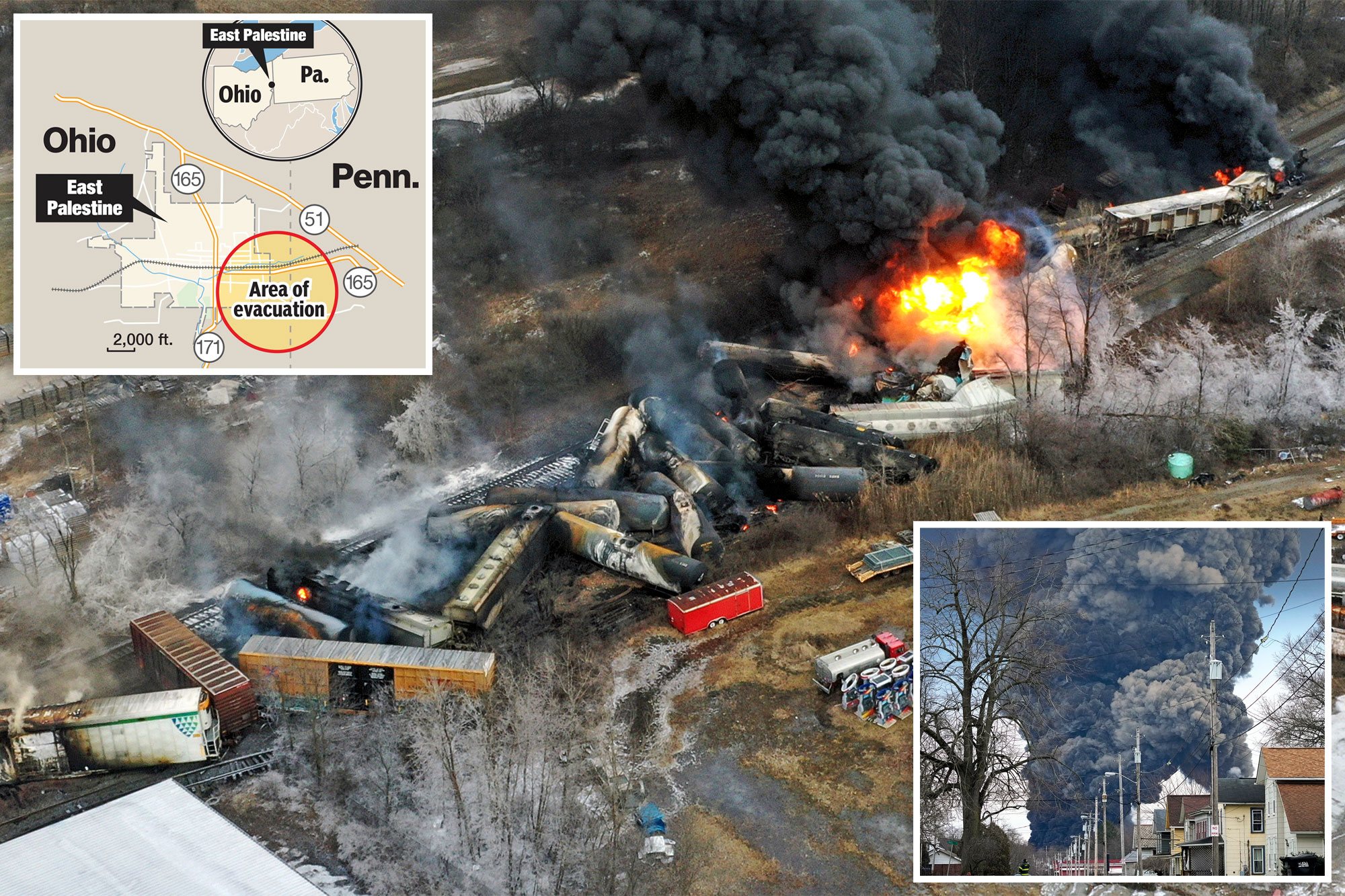Investigation Reveals Lingering Toxic Chemicals Months After Ohio Train Derailment

Table of Contents
Persistent Chemical Contamination in Soil and Water
The derailment released a cocktail of hazardous substances, including vinyl chloride, butyl acrylate, and ethylene glycol monobutyl ether. These chemicals, known for their toxicity, have proven remarkably persistent in the environment.
Soil Testing Results
Preliminary and ongoing soil tests conducted by various agencies, including the EPA and independent researchers, paint a concerning picture. Results indicate significant contamination levels in numerous locations surrounding the derailment site.
- High concentrations of vinyl chloride: Found in soil samples exceeding EPA safety limits by significant margins, posing risks to human health and the surrounding ecosystem. These levels have been detected several hundred yards from the initial derailment site.
- Butyl acrylate and ethylene glycol monobutyl ether detected: These chemicals, also known for their toxicity, have been found in elevated levels in multiple locations, impacting soil health and potentially contaminating groundwater.
- Testing methodology: A range of sophisticated analytical techniques, including gas chromatography-mass spectrometry (GC-MS) and high-performance liquid chromatography (HPLC), were used to accurately identify and quantify the chemicals present in the soil samples.
These findings highlight the potential for long-term impacts on soil health, agricultural productivity, and the potential for leaching into groundwater sources. The full extent of soil contamination remains unclear, necessitating further comprehensive testing.
Water Contamination Concerns
The contamination extends beyond the soil, with significant concerns surrounding local water sources. Reports indicate elevated levels of contaminants in both private wells and surface water bodies.
- Contaminated well water: Numerous residents have reported discolored or foul-smelling water, raising fears about water potability and potential long-term health effects.
- Surface water impact: Local streams and rivers have also shown signs of contamination, impacting aquatic life and potentially affecting downstream communities.
- Water treatment efforts: While water treatment efforts are underway, their long-term effectiveness remains to be seen, and ongoing monitoring is crucial to ensure the safety of drinking water. Water quality testing continues to reveal fluctuating levels of contaminants, highlighting the complexity of the cleanup effort.
Long-Term Health Effects on Residents of East Palestine
The exposure to a toxic mix of chemicals has understandably caused significant worry among East Palestine residents. Reports of various health issues are emerging, raising concerns about potential long-term health consequences.
Reported Health Issues
Many residents are reporting a range of symptoms potentially linked to chemical exposure.
- Respiratory problems: Increased instances of coughing, shortness of breath, and wheezing are being reported, indicating potential damage to the respiratory system.
- Skin irritation: Reports of rashes, itching, and other skin irritations are common, suggesting direct contact with contaminated materials.
- Headaches and nausea: These symptoms are frequently reported, highlighting the potential for systemic effects from chemical exposure.
The number of people affected and the full extent of health problems are still being assessed.
Ongoing Health Studies
Recognizing the urgent need for comprehensive investigation, several epidemiological studies are underway to assess the long-term health consequences of the derailment. These studies will be crucial in understanding the long-term impact on the health of the community and informing future public health interventions.
- Scope of the studies: These studies will involve monitoring the health of residents over an extended period, collecting data on various health outcomes, and investigating potential links to chemical exposure.
- Researchers and timelines: Leading researchers from various institutions are collaborating on these studies, with results expected to be released in the coming years.
Environmental Impact Beyond Immediate Area
The environmental consequences of the Ohio train derailment extend far beyond the immediate vicinity of the accident.
Air Pollution Analysis
Air quality monitoring in the days following the derailment revealed elevated levels of various pollutants, including vinyl chloride and other toxic compounds. The long-term consequences of this air pollution remain a subject of ongoing investigation.
- Pollutant dispersion: Atmospheric models are being used to track the dispersion patterns of these pollutants and assess their potential impact on wider geographical areas.
- Health risks: Inhaled toxic chemicals can cause a variety of health problems, both short-term and long-term, raising concerns about the wider health implications beyond East Palestine.
Wildlife and Ecosystem Impacts
The impact on local wildlife and the broader ecosystem is also a significant concern.
- Observed effects: Reports of dead fish, birds, and other animals have been documented, highlighting the potential for significant ecological damage.
- Ecological assessments: Ongoing ecological assessments are crucial to determine the full extent of the damage and to guide remediation efforts. These assessments will cover a range of species and habitats to understand the impact on the local ecosystem’s overall health.
Government Response and Accountability
The government's response to the derailment and the effectiveness of subsequent regulatory measures are under scrutiny.
Regulatory Oversight
The agencies involved in overseeing the transportation of hazardous materials and responding to environmental disasters face significant challenges and criticism.
- Agency actions: The EPA and other regulatory bodies have undertaken various actions including cleanup efforts and health monitoring, but their effectiveness is debated, with some critics citing a slow response and lack of transparency.
- Criticism of response: The initial response to the derailment was criticized for being insufficient and delayed, leading to concerns about the potential for greater environmental and health damage.
Accountability and Legal Actions
Several investigations and legal actions are underway to determine responsibility and potential liabilities.
- Responsible parties: The ongoing legal proceedings and investigations aim to hold accountable the parties responsible for the derailment and the subsequent environmental damage.
- Potential repercussions: The potential legal repercussions could include substantial fines, remediation costs, and other penalties.
Conclusion
The Ohio train derailment continues to unfold as a profound environmental and public health crisis. Months after the initial incident, lingering toxic chemicals pose a significant threat to the health of East Palestine residents and the environment. The persistent contamination of soil and water, the reported health problems, and the potential for long-term ecological damage underscore the gravity of the situation. The ongoing investigations and health studies are essential steps towards understanding the full impact and guiding effective remediation efforts. We must learn from this disaster, demand stronger regulations for the transportation of toxic chemicals, and support the affected communities as they grapple with the lasting consequences of this devastating event. Stay updated on the latest findings regarding the Ohio train derailment investigation and support the ongoing efforts to remediate the environmental damage caused by the Ohio train derailment. Demand stronger regulations for the transportation of toxic chemicals to prevent future tragedies. Learn more about the lingering effects of the Ohio train derailment and advocate for greater accountability.

Featured Posts
-
 Virginia Giuffre Skandalen Fakta Pastander Og Reaksjoner
May 12, 2025
Virginia Giuffre Skandalen Fakta Pastander Og Reaksjoner
May 12, 2025 -
 Did Michael Kays Inquiry Ignite Juan Sotos Offensive Explosion
May 12, 2025
Did Michael Kays Inquiry Ignite Juan Sotos Offensive Explosion
May 12, 2025 -
 The Making Of A Sixth Man Payton Pritchards Path To A Breakout Nba Season
May 12, 2025
The Making Of A Sixth Man Payton Pritchards Path To A Breakout Nba Season
May 12, 2025 -
 The Next Pope Factors Influencing The Papal Election
May 12, 2025
The Next Pope Factors Influencing The Papal Election
May 12, 2025 -
 Can Adam Sandler Bridge Americas Political Divide
May 12, 2025
Can Adam Sandler Bridge Americas Political Divide
May 12, 2025
Latest Posts
-
 Hostage Edan Alexander Hamas Announces Planned Release
May 12, 2025
Hostage Edan Alexander Hamas Announces Planned Release
May 12, 2025 -
 Colombia Grants Asylum To Former Panama President Martinelli
May 12, 2025
Colombia Grants Asylum To Former Panama President Martinelli
May 12, 2025 -
 The Private Credit Job Market 5 Dos And Don Ts For Landing A Role
May 12, 2025
The Private Credit Job Market 5 Dos And Don Ts For Landing A Role
May 12, 2025 -
 Anchor Brewing Company 127 Years And Counting To Closure
May 12, 2025
Anchor Brewing Company 127 Years And Counting To Closure
May 12, 2025 -
 India Pakistan Conflict Escalates 5 Soldiers Killed Truce Remains In Question
May 12, 2025
India Pakistan Conflict Escalates 5 Soldiers Killed Truce Remains In Question
May 12, 2025
